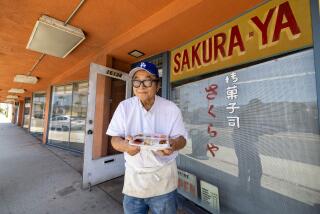Japan Going Nuts Over Co-Op’s Snacks : Exports: California’s Blue Diamond group has carved out a big market in Japan by developing products such as almonds and sardines.
Consider the Calmond, a shiny foil packet of calcium-enriched, slivered almonds courtesy of Blue Diamond Growers. Sound good? Well, don’t look for it soon at a market near you. It’ll never sell in America.
And that’s just the point. Mixing almonds with dried baby sardines--Calmond’s calcium source--is part of an effort by Blue Diamond to create products that suit the Japanese palate for sale in Japan.
In 1989 alone, 100 new almond products were introduced in Japan--some under the Blue Diamond label and others by Japanese manufacturers in conjunction with the Sacramento-based growers cooperative.
The reasoning is simple: Almonds don’t grow in Japan, and as recently as two decades ago they were little-known there. If they’re accessible, Blue Diamond officials figure, they’ll be eaten. And that’s just what’s been happening.
Between 1981 and 1989, California almond exports to Japan rose more than 50%, from 31.5 million pounds to 48.5 million pounds, according to the Almond Board of California. The Japanese market for California almonds is about $100 million annually. Blue Diamond, the biggest grower/producer in the state, controls more than half of that market, said Peggy Leong, almond board manager.
Specialized products played a big part in Blue Diamond’s market growth and in the success of imported food products in general.
“Always American people like the almond exporters should consider what kinds of tastes are in the Japanese market,” says Giro Saito, director of business development for the Japan External Trade Organization. “These American food companies are always market researching the Japanese taste. Even in McDonald’s, the food is a little different, internationalized. Food depends on each area’s local tastes.”
Which is why Calmond, introduced in 1986 and distributed throughout Japan in a joint marketing effort between Blue Diamond and Coca-Cola bottlers, was such a success.
“We literally could not keep up with the demand,” says Rex Lake, Blue Diamond’s sales manager for Asia and the Pacific Rim. “The popularity of Calmond caused a dried fish shortage in Japan for a couple of years, 1987 and 1988. We never ran out of almonds, but we damn near ran out of fish.”
The problem was that the baby sardines, called iriko , must be caught before they get too big. There’s a one-month window each year when the best iriko are available. Two years ago, Lake said, the unexpected demand for Calmond took the iriko suppliers by surprise, and they were not prepared.
Calmond was originally targeted for Japanese children and distributed through the school lunch program, which feeds 98% of the country’s elementary school students. Milk products, the traditional calcium source for American children, are not as common in the Japanese diet. Sardines are.
“Dried fish is an excellent source of calcium,” Lake says, “but kids in Japan tend not to like dried fish any more than kids in the U.S. One way to get them to eat it is to combine it with almonds. . . . But what happened is that kids liked the product well enough, but it caught on and became tremendously popular with adults as something to eat while drinking a beer or a Coke.”
Soon after Calmond’s success, Lake said, Blue Diamond introduced Green Onion Almonds, Soy Almonds and Sweetee Almonds. Another popular snack is the soft almond, which gets the sweetness and texture of a prune through a fermenting process.
Almond Peptide, a Japanese counterpart to Bromo Seltzer, is another almond success, this one produced by a Japanese pharmaceutical company. In Japan, almonds are touted for their healthful properties. Almond Peptide is a protein extract made from almond kernels and used as a remedy for stomach troubles and headaches.
The Almond Brisky Ball hit the shelves in late 1989, Lake said, manufactured by Glico Confectionary with development input by Blue Diamond. The snack product is an almond covered in rice cracker and dipped in chocolate.
Then there’s the Calorie Mate, an almond health bar manufactured by Otsuka Pharmaceutical of Tokyo, with development help from Blue Diamond. The snack is succeeding because of a new interest in healthy eating, Lake said. It’s an instant breakfast of sorts that combines almonds, flour, sugar, nonfat skim milk and bean protein.
And many more applications are in the works. A teriyaki-flavored almond and a squid-flavored almond are in development for sale under the Blue Diamond label, said marketing director Christine McGlasson. And the cooperative’s Japanese development staff is working with manufacturers to produce breakfast cereals.
Lake calls this a “new phenomenon,” a marketing opportunity presented by the Japanese consumer’s break with the traditional breakfast of miso soup, cold rice, pickles and fish. “More and more, the young people and some of the working people are drifting over to a piece of toast, yogurt, breakfast cereal. That creates all kinds of marketing opportunities for quick and easy breakfast products.”
More to Read
Eat your way across L.A.
Get our weekly Tasting Notes newsletter for reviews, news and more.
You may occasionally receive promotional content from the Los Angeles Times.











